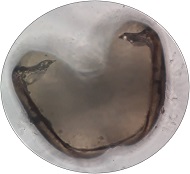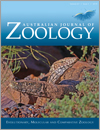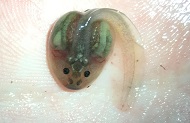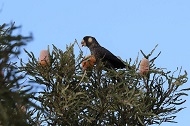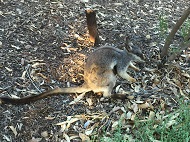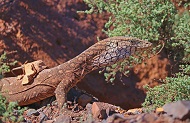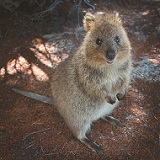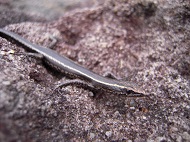Australian Journal of Zoology
Volume 67
Number 1 2019
Freshwater mussels have parasitic larvae (glochidia) that attach to host fishes as a dispersal mechanism. This study is a description of the glochidia of Alathyria pertexta pertexta from south-eastern Queensland, Australia. Glochidial shells measure 0.268 mm long × 0.242 mm high, are subtriangular and scalene in shape and have smooth singular S-shaped ‘larval teeth’ on opposing valves.
Photo by Michael W. Klunzinger.
Sandpaper frog (Lechriodus fletcheri) tadpoles are laid in highly ephemeral pools that are generally nutrient poor. We observed tadpoles hunting mosquito larvae in pools within the Watagan Mountain, New South Wales. This behaviour suggests generalised tadpole species may take up multiple ecological roles in freshwater systems, including opportunistic predators.
Photo by John Gould.
Effective conservation planning for Carnaby’s cockatoo is dependent on quantifying yield (expressed as the mean number of follicles and seeds per infructescence) and the average energetic reward from seed from six species of Banksia on the Swan coastal plain, Western Australia. Over 50% of intact infructescences were manipulated for seed for all Banksia species. Seed energy reward was similar for all six species (20–23 kJ g–1).
Photo by Karen Riley.
The black-footed rock-wallaby (Petrogale lateralis) is the most widespread rock-wallaby species in Australia. Morphological and genetic differences within this species have long been recognised, with three subspecies and two races currently recognised. In this paper we review existing evidence and formally name the MacDonnell Ranges race and West Kimberley race as subspecies of P. lateralis.
Photo by Mark Eldridge.
Understanding the processes driving animal responses to habitat change is vital to their conservation. We use GPS/VHF tracking and the T-LoCoH method to analyse movement and activity of a Varanus giganteus to habitat alteration and differing thermal environments at a Mid West Western Australian mine site.
The ‘world’s happiest animal’, the quokka, is a highly charismatic, monotypic species found in the biodiversity hotspot region of south-west Western Australia, but their genetic diversity remains poorly documented. We use genetic information from a large sample of quokkas from around their ~800-km range to identify population fragmentation problems, including the role that island populations contribute to their conservation. Overall, spatial and population cluster analysis showed small insular populations in the northern jarrah forest area, but in the southern forests there appears to be a large panmictic population.
Photo by Rottnest Island Authority.
Understanding the natural history of species is essential for successful conservation and management. Our study investigates the life history and ecology of elegant snake-eyed skinks (Cryptoblepharus pulcher) in south-eastern Australia. This species reaches maturity within one year, has a lifespan of at least three years, has an average clutch size of two eggs, and shelters under rocks that are warmer than unused rocks, and occasionally shared with conspecifics, but not predatory snakes.
Photo by David A. Pike.
